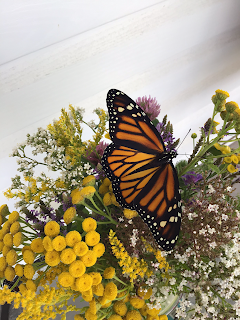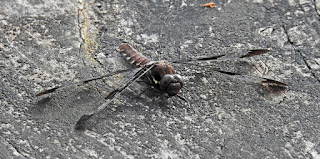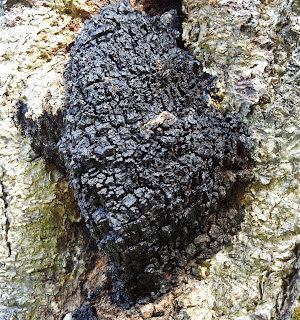NATURE
MONCTON INFORMATION LINE, August 18, 2020
(Tuesday)
To respond by e-mail, please address
your message to the information line editor, nelsonpoirier435@gmail.com .
Please advise the editor at nelsonpoirier435@gmail.com if any
errors are noted in wording or photo labelling.
Edited by: Nelson Poirier nelsonpoirier435@gmail.com
Info Line # 506-384-6397 (384-NEWS)
**
Marguerite Winsor sends two beautiful photos of a freshly emerged female and
male MONARCH BUTTERFLY
[Monarque]. Out of 16
chrysalids, 13 have hatched so far and the last 3 will probably be gone by
Wednesday. Marguerite comments it's always a fun project and this year she was
able to witness the last Monarch caterpillar with the amazing transformation
from caterpillar to chrysalis. She was keeping an eye on this last caterpillar
and just happened to notice that the J-shape had changed to a straight line and
it happened. It split from the bottom and it was pretty well done in maybe
twenty seconds. Amazing!
** Burnt
over areas create habitat for certain species. Mike Plourde went to the Cains
River via the Rogersville Pleasant Ridge Rd. on Sunday to come across a burned
over area from June of 2020. He was interested to find many WOODPECKERS
including 1 female and 2 male BLACK-BACKED WOODPECKERS [Pic à dos noir]. He got no photos but leaves the
location on Google Map Photo link below if someone is interested in checking it
out. Also, lots of PALM WARBLER [Paruline à couronne rousse] and 3 BLACK BEARS [Ours noir] in separate sightings. He did not bother them and
they did not bother him!
** Carol
Shea had a BOBCAT [Lynx
roux] come into
her Upham yard appearing to be hunting SQUIRRELS [Ecureuil] that were in the area. It appears quite thin and appears
to need something more substantial than a squirrel. It was very likely hunger
that brought the animal to the yard during the day. Carol was able to get a few
photos of its mission that was not successful.
Georges Brun
paid a visit to Bis Marsh Monday evening to find no water in pond area.
From spring to now down a little more than 30 cm or approximately 1 foot.
Someone walked a distance on the dried surface and left footprints
approximately 4 to 5 cm. Even with the rain Monday morning there was
insignificant inroads to start the filling process. This leaves this productive
marsh site not attractive to shorebirds and water fowl.
** Yvette
Richard got a photo of a RUBY-THROATED HUMMINGBIRD [Colibri à gorge rubis] in a
swordfight with uninvited nectar-seeking insects to her hummingbird feeder. It
can be a problem at this time of year.
Yvette
also got a Great Blue Heron with a bit of a ‘punky’ look at the Sackville
Waterfowl Park
** Still
more LITTLE BLUE HERON
[Aigrette bleue] juvenile photos to enjoy. Brian Stone found them at
the Sackville Waterfowl Park on Sunday. They seemed to be foraging mainly on
FROGS as other observers have noted. One heron was in a tree but at a distance.
There was also a DOUBLE-CRESTED CORMORANT [Cormoran à aigrettes] using a swallow
nest box as a perch there, and two DRAGONFLY species, the COMMON WHITETAIL
DRAGONFLY [libellule lydienne] and the
VARIABLE DARNER DRAGONFLY [æschne domino].
** It’s a
great time of year to observe some of the larger female spiders that can be
quite colourful this time of year. I came across a CROSS SPIDER [épeire diadème]
in St. Martin's recently. It was not particularly impressed with being
photographed.
** The CHAGA MUSHROOM is not a particularly
attractive mushroom as it appears as a black, rough, canker-type of growth on
usually YELLOW or WHITE BIRCH. It has become very popular as a medicine, making
a tea-type of drink from it. The ground powder sells for surprising prices at
the moment. It is used very extensively in Russia and Balkan countries. If the
outer black is peeled back a light-brown interior is exposed, as the photo
shows. This is what is often ground up in a coffee grinder to prepare the
drink. The black outside contains rather bitter turpins, however some
literature suggests this may be the greater concentration of the medicine that it’s
used for. There has been little controlled medical research in North America to
prove its value as a medicine. I came across one on Friday and was a bit
surprised to see it. It gets gathered very quickly in easily accessible areas.
Nelson Poirier,
Nature Moncton
LITTLE BLUE HERON (JUVENILE). AUG. 16, 2020. BRIAN STONE
LITTLE BLUE HERON (JUVENILE). AUG. 16, 2020. BRIAN STONE
LITTLE BLUE HERON (JUVENILE). AUG. 16, 2020. BRIAN STONE
LITTLE BLUE HERON (JUVENILE). AUG. 16, 2020. BRIAN STONE
LITTLE BLUE HERON (JUVENILE). AUG. 16, 2020. BRIAN STONE
LITTLE BLUE HERON (JUVENILE). AUG. 16, 2020. BRIAN STONE
LITTLE BLUE HERONS (JUVENILE). AUG. 16, 2020. BRIAN STONE
GREAT BLUE HERON. AUG 14, 2020. YVETTE RICHARD
RUBY-THROATED HUMMINGBIRD. AUG 16, 2020 YVETTE RICHARD
DOUBLE-CRESTED CORMORANT. AUG. 16, 2020. BRIAN STONE
MONARCH BUTTERFLY (MALE) AUG 17, 2020. MARGUERITE WINSOR
MONARCH BUTTERFLY (FEMALE) AUG 17, 2020. MARGUERITE WINSOR
COMMON WHITETAIL DRAGONFLY (FEMALE). AUG. 16, 2020. BRIAN STONE
VARIABLE DARNER DRAGONFLY. AUG. 16, 2020.. BRIAN STONE
CROSS SPIDER. AUG 15, 2020. NELSON POIRIER
CHAGA MUSHROOM. AUG 14, 2020. NELSON POIRIER
CHAGA MUSHROOM. AUG 14, 2020. NELSON POIRIER
CHAGA MUSHROOM (CUT INTO). AUG 14, 2020. NELSON POIRIER
BOBCAT. AUG. 15, 2020. CAROL SHEA
BOBCAT. AUG. 15, 2020. CAROL SHEA
BOBCAT. AUG. 15, 2020. CAROL SHEA
BIS MARSH (DRIED DOWN). AUG 17, 2020. GEORGES BRUN






















No comments:
Post a Comment